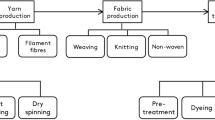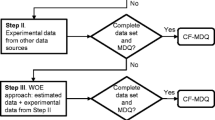Abstract
Purpose
The use and emission of chemicals and the intrinsic toxic properties of some of these chemicals are an important topic in the textile industry. Quantitative evaluation of toxic impacts is a life cycle assessment (LCA) approach, termed “toxic footprint” in this article. We ask whether calculation of toxic footprints is a useful method to steer the textile industry towards more sustainable use of chemicals.
Methods
Three different methods by which strategic product toxicity assessment can be performed within the context of LCA are illustrated and compared using a wet treatment process for a cotton T-shirt as the basis of a case study. The methods are the USEtox model chosen for the European Product Environmental Footprint work, the Score System presented in the European Commission’s Reference Document on Best Available Techniques for the Textiles Industry, and the Strategy Tool presented by Askham. The methods are compared in terms of their ease of use and whether the results give a consistent evaluation of a set of chemicals.
Results and discussion
New USEtox characterisation factors for textile chemicals were calculated and used for this article. The results show that the three methods do not give a consistent evaluation of the different wet treatment chemicals. Both the Score System and the Strategy Tool are very concerned with persistent contaminants such as the optical brightener in this case study, which is deemed to be less important by USEtox. The calculations also show how the results generated by the USEtox model depend on whether users apply (1) only the recommended characterisation factors or (2) these and the interim characterisation factors or (3) these and the new characterisation factors calculated for this article.
Conclusions and recommendations
With current policy initiatives such as the Product Environmental Footprint now being applied for textile products, toxicity assessment will by default be performed in the LCA of textiles. It is important that the results are relevant and representative as the intended users are supposed to take actions based on them. Confidence in the results is crucial for a scientific method, and therefore, this exploratory comparison exercise shows how benchmarking can be a tool to make the differences in background assumptions explicit, to better understand the differences in the results, and help create such confidence.


Similar content being viewed by others
References
Alfonsín C, Hospido A, Omil F, Moreira MT, Feijoo G (2014) PPCPs in wastewater—update and calculation of characterization factors for their inclusion in LCA studies. J Clean Prod 15:245–255
Ash M, Ash I (2004) Handbook of green chemicals, 2nd ed. Endicott, NY : Synapse Information Resources, New York
Askham C (2011) Environmental product development combining the life cycle perspective with chemical hazard information. Aalborg University, Department of Planning, Aalborg, Denmark
Askham C, Gade AL, Hanssen OJ (2012) Combining REACH, environmental and economic performance indicators for strategic sustainable product development. J Clean Prod 35:71–78
COM (2003) Communication from the Commission to the Council and the European Parliament. Integrated Product Policy. Brussels
Commission E (2003) Integrated pollution prevention and control (IPPC) reference document on best available techniques for the textiles industry. European IPPC Bureau, Seville
Čuček L, Klemeš JJ, Kravanja Z (2012) A review of footprint analysis tools for monitoring impacts on sustainability. J Clean Prod 34:9–20
European Commission (2008) Regulation (EC) No 1272/2008 of the European Parliament and of the Council of 16 December 2008 on classification, labelling and packaging of substances and mixtures, amending and repealing Directives 67/548/EEC and 1999/45/EC, and amending Regulation (EC). Off. J. Eur. Union 353
European Commission (2010) International Reference Life Cycle Data System (ILCD) Handbook—general guide for life cycle assessment—detailed guidance, 1st ed. Publications Office of the European Union, Luxembourg. 10.2788/38479
European Commission (2011) International Reference Life Cycle Data System (ILCD) Handbook—recommendations for life cycle impact assessment in the European context, 1st ed. EUR 24571 EN. Publications Office of the Europe, Luxemburg
European Commission (2013) Commission Recommendation of 9 April 2013 on the use of common methods to measure and communicate the life cycle environmental performance of products and organisations. Off. J. Eur. Union 56
Gouin T, Cousins I, Mackay D (2004) Comparison of two methods for obtaining degradation half-lives. Chemosphere 56:531–5
Hauschild MZ, Jolliet O, Huijbregts MAJ (2011) A bright future for addressing chemical emissions in life cycle assessment. Int J Life Cycle Assess 16:697–700
Hitchcock K, Panko J, Scott P (2012) Incorporating chemical footprint reporting into social responsibility reporting. Integr Environ Assess Manag 8:386–388
Igos E, Moeller R, Benetto E, Biwer A, Guiton M, Dieumegard P (2014) Development of USEtox characterisation factors for dishwasher detergents using data made available under REACH. Chemosphere 100:160–166
Krozer A, Björk A, Hanning A-C, Wendel A, Magnusson E, Persson F, Holmberg K, Jelse K (2011) Clean development and demonstration—sustainable domestic washing—s’wash. Final report. IVL Swedish Environmental Research Institute, Stockholm, Sweden
Laurent A, Olsen SI, Hauschild MZ (2012) Limitations of carbon footprint as indicator of environmental sustainability. Environ Sci Technol 46:4100–4108
Laursen SE, Hansen J, Andersen TA, Knudsen HH (2002) Danish experience. Best Available Techniques—BAT—in the clothing and textile industry, Working Re. ed. Danish EPA, Copenhagen, Denmark
Munn K (2011) The chemicals in products project: case study of the textiles sector. Switzerland, Geneva
OECD SIDS (2001) SIDS initial assessment report on fluorescent brightener 220. Bern, Switzerland
OECD (2014) Categorization results from the Canadian Domestic Substance List (CCRWEB) [WWW Document]. URL http://webnet.oecd.org/CCRWEB/Default.aspx (accessed 6.1.14)
Outdoor Industry Association (2014) Chemicals Management Working Group (CMWG) [WWW Document]. URL http://outdoorindustry.org/responsibility/chemicals/index.html (accessed 6.1.14)
Owsianiak M, Laurent A, Bjørn A, Hauschild MZ (2014) IMPACT 2002+, ReCiPe 2008 and ILCD’s recommended practice for characterization modelling in life cycle impact assessment: a case study-based comparison. Int J Life Cycle Assess 19:1007–1021
Perry DL (2011) Handbook of inorganic compounds, 2nd ed. CRC Press
Peters GM, Blackburn NJ, Armedion M (2013) Environmental assessment of air to water machines—triangulation to manage scope uncertainty. Int J Life Cycle Assess 18:1149–1157
Raptis CE, Juraske R, Hellweg S (2008) Aquatic ecotoxicity of whole effluents effect factor: methodology 1–4
Roos S, Posner S, Jönsson C, Peters GM (2015) Is unbleached cotton better than bleached? Exploring the limits of life cycle assessment in the textile sector. Cloth Text Res J. doi:10.1177/0887302X15576404
Rosenbaum RK, Bachmann TM, Gold LS, Huijbregts MAJ, Jolliet O, Juraske R, Koehler A, Larsen HF, MacLeod M, Margni M, McKone TE, Payet J, Schuhmacher M, Meent D, Hauschild MZ (2008) USEtox—the UNEP-SETAC toxicity model: recommended characterisation factors for human toxicity and freshwater ecotoxicity in life cycle impact assessment. Int J Life Cycle Assess 13:532–546
Rosenbaum RK, Huijbregts MAJ, Henderson AD, Margni M, McKone TE, Meent D, Hauschild MZ, Shaked S, Li DS, Gold LS, Jolliet O (2011) USEtox human exposure and toxicity factors for comparative assessment of toxic emissions in life cycle analysis: sensitivity to key chemical properties. Int J Life Cycle Assess 16:710–727
Rowley HV, Peters GM, Lundie S, Moore SJ (2012) Aggregating sustainability indicators: beyond the weighted sum. J Environ Manag 111:24–33
SAC (2012) Sustainable Apparel Coalition (SAC) [WWW Document]. URL http://www.apparelcoalition.org/ (accessed 8.24.13)
Sala S, Goralczyk M (2013) Chemical footprint: a methodological framework for bridging life cycle assessment and planetary boundaries for chemical pollution. Integr Environ Assess Manag 9:623–32
Sala S, Pant R, Hauschild M, Pennington D (2012) Research needs and challenges from science to decision support lesson learnt from the development of the International Reference Life Cycle Data system (ILCD) recommendations for Life Cycle Impact Assessment. Sustainability 4:1412–1425
Mistra Future Fashion (2014) Mistra future fashion [WWW Document]. URL http://www.mistrafuturefashion.com (accessed 6.1.14)
TEGEWA (2008) TEGEWA’s International Textile Auxiliaries Buyer’s Guide 2008/09. Deutscher Fachverlag GmbH, Frankfurt am Main
Terinte N, Manda BMK, Taylor J, Schuster KC, Patel MK (2014) Environmental assessment of coloured fabrics and opportunities for value creation: spin-dyeing versus conventional dyeing of modal fabrics. J Clean Prod 72:127–138
United Nations (2011) Globally Harmonized System of classification and labelling of chemicals (GHS), 4th ed, US Environmental Agency, Arlington USA. United Nations, New York and Geneva
USEPA (2007) Estimation Programs Interface EPI Suite [WWW Document]. URL http://www.epa.gov/oppt/exposure/pubs/episuitedl.htm (accessed 6.1.14)
ZDHC (2014) Roadmap to Zero Discharge of Hazardous Compounds (ZDHC) [WWW Document]. URL http://www.roadmaptozero.com/ (accessed 6.1.14)
Acknowledgements
The researchers acknowledge the support of the Swedish funding agency Mistra in the Mistra Future Fashion programme.
Author information
Authors and Affiliations
Corresponding author
Additional information
Responsible editor: Ralph K. Rosenbaum
Electronic supplementary material
Below is the link to the electronic supplementary material.
ESM 1
(DOCX 49 kb)
Rights and permissions
About this article
Cite this article
Roos, S., Peters, G.M. Three methods for strategic product toxicity assessment—the case of the cotton T-shirt. Int J Life Cycle Assess 20, 903–912 (2015). https://doi.org/10.1007/s11367-015-0895-6
Received:
Accepted:
Published:
Issue Date:
DOI: https://doi.org/10.1007/s11367-015-0895-6




